| Srl | Item |
| 1 |
ID:
092637
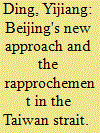

|
|
|
| 2 |
ID:
146166
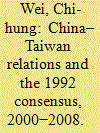

|
|
|
|
|
| Summary/Abstract |
After mid-2000, Beijing inclusively redefined ‘one China’ as ‘both the mainland and Taiwan belonged to one China’. It also advocated the ‘peaceful development’ of China–Taiwan relations. Why did China moderate its Taiwan policy? I argue that the ‘1992 consensus’—a term invented and promoted by pan-Kuomintang (KMT) actors to describe the spirit of cross-Strait détente during 1992–1995—constituted China's policy moderation. Pan-KMT actors persuaded Beijing that its coercive approaches had alienated the Taiwanese people and that a conciliatory approach might win their hearts and minds. Accepted by Beijing, the 1992 consensus constructed China's Taiwan policy after 2000. Although Beijing has somewhat deemphasized the 1992 consensus since 2012, the term has established a legacy of appropriateness that Beijing is unlikely to undo in the short-to-medium term. In comparison with the Taiwanese case, no Hong Kong actors have played a role in persuading Beijing to keep its ‘one country, two systems’ promise.
|
|
|
|
|
|
|
|
|
|
|
|
|
|
|
|
| 3 |
ID:
113043
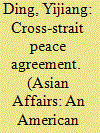

|
|
|
|
|
| Publication |
2012.
|
| Summary/Abstract |
In spite of the fact that substantial progress has been made in the improvement of relations between China and Taiwan, 1
there have been no talks on sensitive political issues. Beijing's proposal for a cross-strait peace agreement is put on hold. Disagreement over the sovereignty of one China and the political reality in Taiwan have conspired to create an apparent impasse and contributed to an indefinite delay of the negotiations. At the moment, a large section of Taiwanese people do not seem to want this peace agreement. The ruling Chinese Nationalist Party (KMT) cannot afford to start negotiations without a strong domestic consensus. This article examines the political situation in Taiwan, analyzes the main obstacles to reaching a cross-strait peace agreement, and explores possible solutions.
|
|
|
|
|
|
|
|
|
|
|
|
|
|
|
|
| 4 |
ID:
164966
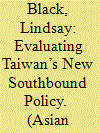

|
|
|
|
|
| Summary/Abstract |
Critiques of Taiwanese President Tsai Ing-wen’s New Southbound Policy overemphasize Beijing’s ability to hinder what is essentially a rational economic move that was already underway prior to Tsai’s inauguration. China’s antagonistic stance toward the New Southbound Policy merely pushes Taiwan into the hands of Japan, China’s regional rival.
|
|
|
|
|
|
|
|
|
|
|
|
|
|
|
|
| 5 |
ID:
173980


|
|
|
|
|
| Summary/Abstract |
The study begins with descriptions of the changing political landscape of Taiwan’s domestic politics and China’s increasingly influential role in global politics to show the strategic terrain of asymmetric relations between the People’s Republic of China and Taiwan (cross-Strait relations) and some lessons of Taiwan’s 2016 elections. It attempts to delineate the 19th Party Congress report for meaningful contemplation of and conjecture about China’s purposes and policies in dealing with the prickly Taiwan issue. In essence, China’s policy under Xi Jinping after the 19th Party Congress has been characterized by a dualist approach in which a soft power charm offensive has been the primary strategy to appeal to the Taiwanese public, whereas coercive measures in the diplomatic arena and military sphere have served as the supplementary approach to pressure the Democratic Progressive Party government.
|
|
|
|
|
|
|
|
|
|
|
|
|
|
|
|
| 6 |
ID:
179941
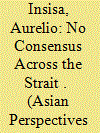

|
|
|
|
|
| Summary/Abstract |
After the 2016 elections, cross-Strait relations have fallen to their lowest point since the Third Strait Crisis. A proliferation of state-driven strategic narratives by both sides has since emerged. Against Beijing's narratives of "national rejuvenation," peaceful reunification, and "1992 Consensus," the Tsai administration has contraposed an image of Taiwan as a "beacon" of freedom and democracy in the Indo-Pacific. By tracing the tenets and the operationalization of Beijing and Taipei's strategic communications from the late 2000s to 2020, this article shows how Chinese and Taiwanese actors' reactions to the systemic pressure of a shifting East Asian regional order have progressively shaped cross-Strait communicative dynamics, severely constraining the range of options that could overcome the current impasse.
|
|
|
|
|
|
|
|
|
|
|
|
|
|
|
|
| 7 |
ID:
146896
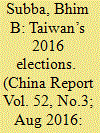

|
|
|
|
|
| Summary/Abstract |
This article examines the recent Presidential and Legislative Yuan (LY, 立法院) elections in Taiwan. The Democratic Progressive Party (DPP) swept elections at both levels. Its candidate was elected as the island’s first female president. On the other hand, the ruling Kuomintang (KMT) lost its majority in the legislature for the first time since competitive electoral democracy began in Taiwan. These elections saw a change in the agenda of the major parties, especially that of the DPP, on various domestic and external issues. At the same time, the growth of student and civil society movements and their participation in the political arena since the 2014 Sunflower movement have carved out a niche in Taiwanese politics today. This article offers some preliminary comments on the significance and impact of the elections on Taiwan’s changing domestic and political landscape, with the emergence of new political forces and socio-economic challenges, along with nebulous Cross–Strait relations and ‘shrinking’ international space and diplomacy. How TsaiIng-wen’s administration after 20 May will deal with these intricate issues will be a test for her presidency.
|
|
|
|
|
|
|
|
|
|
|
|
|
|
|
|
| 8 |
ID:
146905
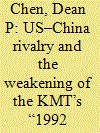

|
|
|
|
|
| Summary/Abstract |
The PRC’s increasingly assertive foreign policy behaviors have triggered heightened anxiety among its regional neighbors. Washington has abided by a long-standing strategic ambiguity policy to manage the Taiwan Strait impasse. However, as the KMT’s “1992 consensus” policy places Taiwan in close union with Beijing, Taipei’s security positions sometimes go against the interests of the US and its allies in the Asia-Pacific. Pulling Taiwan away from China’s orbit is congruent with US interest in continuing that enduring policy framework and ensuring a healthy balance across the Strait.
|
|
|
|
|
|
|
|
|
|
|
|
|
|
|
|